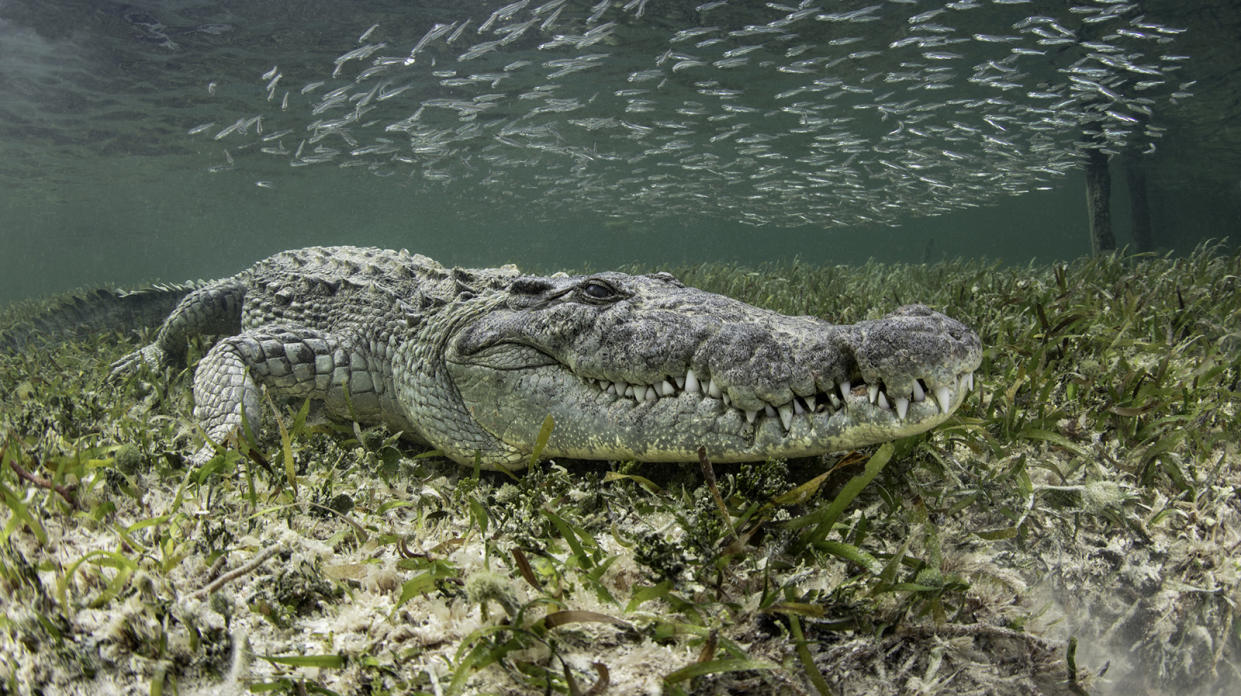7 of the Largest Crocodiles Ever Measured

Crocodiles are impressively large reptiles. A male American crocodile can measure as much as 20 feet (6.1 meters) long, though they typically end up closer to 14 feet (4.3 meters) long. And it may be hard to imagine, but a very special few crocodylians make the average measurements of those apex predators seem modest.
As a matter of fact, one of the largest crocodiles ever was so big that one website called the species "bus-sized." Let that sink in for a moment.
As we look at both extinct and current species of the largest crocodiles ever recorded, be thankful this article can't jump out of the screen at you.
3 of the Largest Extinct Crocodylians
Unlike living crocodiles, measuring extinct crocodiles can be difficult. "Estimating the body size of extinct crocodyliforms can be challenging, given the distinct body proportions of different subgroups, especially those phylogenetically distant from living crocodylians," according to researchers behind a 2022 study.
"Nevertheless, this issue is attenuated when skeletal measurements from extant crocodylians are used to estimate the body sizes of close extinct relatives, a practice that has been done by many studies, using different measurements to estimate body size (e.g. femoral length, vertebral measures, cranial width, orbito-dorsal cranial length, dorsal cranial length)."
Here are a few of the largest extinct crocodiles and their estimated size.
3. Mourasuchus
Despite its impressive size — the mourasuchus was an estimated 21.7 feet (6.6 meters) in length — this species likely did not handle large prey. This crocodylian had a flattened, duck-like skull and small teeth, meaning it likely didn't have the requisite bite force to take down bigger animals.
2. Sarcosuchus imperator
This giant reptile lived during the Cretaceous period in Africa. Based on fossil evidence, scientists estimate the croc was 11 to 12 meters (36 to 39 feet) long and weighed about 8 metric tons (8.8 U.S. tons).
These giant crocodiles had elongated powerful jaws that could have helped them eat fish and dinosaurs. "They do seem to have been going after pretty much anything they could," says Dr. Mark Young, an expert in vertebrate paleontology, to the BBC.
"By the time they reached their maximum body size, they probably would have been a predator of anything," he continued. "It's not really clear if they were capable of lunging out of the water and grabbing a dinosaur or if they just stuck to grabbing large fish in the rivers. It's possible once they reached really large body size, they could have done both."
1. Purussaurus brasiliensis
The middle to late Miocene era brought the Purussaurus brasiliensis, a crocodylian based in South America. Researchers estimate that it reached 41 feet (12.5 meters) in length, weighed about 8.4 metric tons and had no competition:
"The extreme size and strength reached by this animal seems to have allowed it to include a wide range of prey in its diet, making it a top predator in its ecosystem. As an adult, it would have preyed upon large to very large vertebrates, and, being unmatched by any other carnivore, it avoided competition."
4 of the Largest Living Crocodiles
While some of today's largest crocodiles may not compare in size to the biggest crocodile of another era, they are still formidable creatures.
4. American Crocodile
The American crocodile (Crocodylus acutus) can reach lengths of 20 feet (6.1 meters), but they more typically hover around 14 feet (4.3 meters long). You can find this giant crocodile in Florida, Cuba and Jamaica, as well as parts of Mexico, Central America and South America.
An American crocodile eats small mammals, crabs, snakes, turtles, birds and fish. While it doesn't have any predators, other animals prey on the croc's hatchlings.
3. Nile Crocodile
One of the biggest crocodiles, Crocodylus niloticus is on average 16 feet (4.9 meters) but can reach up to 18 feet (5.5 meters). The croc has a pointed snout and teeth that protrude when it closes its mouth. Its natural habitat is in Africa, but people have spotted them far from home, like in the Everglades National Park in Florida.
A crocodile farm breeds crocs for food and leather. The Nile crocodile is one such croc found on these farms.
2. Orinoco Crocodile
Orinoco crocodiles (Crocodylus intermedius) measure in at about 22 feet (6.7 meters). Crocodile hunters seek these endangered crocs because of their large size. In Venezuela and Colombia, orinocos live within protected areas.
1. Saltwater Crocodile
The saltwater crocodile (Crocodylus porosus) is typically 17 feet (5.2 meters) long, but it can reach 23 feet (7 meters). Also known as the estuarine crocodile, this species holds the title of the world's largest crocodile. You can find saltwater crocodiles in Asia and Australia.
The largest saltwater crocodile in captivity was Lolong. The croc measured 20.24 feet (6.17 meters). Lolong died in 2013.
The Current Record Holder
Even crocodiles can set Guinness World Records. Cassius, an Australian saltwater crocodile (Crocodylus porosus), set the record for the largest crocodile in captivity (living) in 2011. Back then, he measured 17 feet, 11.75 inches (5.48 meters).
Cassius resided at Marineland Melanesia in Green Island, Australia. Sadly, hedied on Nov. 2, 2024. Scientists estimated his birth year could have been as early as 1903. Whether or not he was born quite so long ago, experts agree he was over 100 years old.
Original article: 7 of the Largest Crocodiles Ever Measured
Copyright © 2024 HowStuffWorks, a division of InfoSpace Holdings, LLC, a System1 Company


